Scientometric Analysis on Rice Research under Drought, Waterlogging or Abrupt Drought-Flood Alternation Stress
Abstract
1. Introduction
2. Material and Methods
2.1. Data Source
2.2. Analysis Software
2.3. Assessment Criteria
3. Results and Discussion
3.1. Analysis of Annual Publication Trend
3.2. Analysis of Main Categories and Journals
3.3. Analysis of Authors, Institutions and Countries
3.4. Analysis of Highly Cited Papers in Total Local Citations
3.5. Analysis of Keywords
4. Conclusions
Author Contributions
Funding
Institutional Review Board Statement
Informed Consent Statement
Data Availability Statement
Acknowledgments
Conflicts of Interest
References
- Sun, G.; Van de Wiele, T.; Alava, P.; Tack, F.; Du Laing, G. Arsenic in cooked rice: Effect of chemical, enzymatic and microbial processes on bioaccessibility and speciation in the human gastrointestinal tract. Environ. Pollut. 2012, 162, 241–246. [Google Scholar] [CrossRef] [PubMed]
- Linkemer, G.; Board, J.E.; Musgrave, M.E. Waterlogging effects on growth and yield components in late-planted soybean. Crop Sci. 1998, 38, 1576–1584. [Google Scholar] [CrossRef] [PubMed]
- Fischer, R.A.T.; Edmeades, G.O. Breeding and Cereal Yield Progress. Crop Sci. 2010, 50, 85–98. [Google Scholar] [CrossRef]
- Haefele, S.M.; Jabbar, S.M.A.; Siopongco, J.D.L.C.; Tirol-Padre, A.; Amarante, S.T.; Sta Cruz, P.C.; Cosico, W.C. Nitrogen use efficiency in selected rice (Oryza sativa L.) genotypes under different water regimes and nitrogen levels. Field Crops Res. 2008, 107, 137–146. [Google Scholar] [CrossRef]
- Yang, J.J.; Zhang, J.J.; Wang, Z.Z.; Zhu, Q.Q.; Wang, W.W. Hormonal Changes in the Grains of Rice Subjected to Water Stress during Grain Filling1. Plant Physiol. 2001, 127, 315–323. [Google Scholar] [CrossRef]
- Kumar, A.; Nayak, A.K.; Das, B.S.; Panigrahi, N.; Dasgupta, P.; Mohanty, S.; Kumar, U.; Panneerselvam, P.; Pathak, H. Effects of water deficit stress on agronomic and physiological responses of rice and greenhouse gas emission from rice soil under elevated atmospheric CO2. Sci. Total Environ. 2019, 650, 2032–2050. [Google Scholar] [CrossRef]
- Mishra, S.S.; Panda, D. Leaf Traits and Antioxidant Defense for Drought Tolerance during Early Growth Stage in Some Popular Traditional Rice Landraces from Koraput, India. Rice Sci. 2017, 24, 207–217. [Google Scholar] [CrossRef]
- Nguyen, H.T.; Babu, R.C.; Blum, A. Breeding for Drought Resistance in Rice: Physiology and Molecular Genetics Considerations. Crop Sci. 1997, 37, 1426–1434. [Google Scholar] [CrossRef]
- Zhang, J.; Li, G.; Song, Y.; Liu, Z.; Yang, C.; Tang, S.; Zheng, C.; Wang, S.; Ding, Y. Lodging resistance characteristics of high-yielding rice populations. Field Crops Res. 2014, 161, 64–74. [Google Scholar] [CrossRef]
- Ullah, H.; Datta, A.; Shrestha, S.; Ud Din, S. The effects of cultivation methods and water regimes on root systems of drought-tolerant (RD6) and drought-sensitive (RD10) rice varieties of Thailand. Arch. Agron. Soil Sci. 2017, 63, 1198–1209. [Google Scholar] [CrossRef]
- Suralta, R.R.; Kano-Nakata, M.; Niones, J.M.; Inukai, Y.; Kameoka, E.; Tran, T.T.; Menge, D.; Mitsuya, S.; Yamauchi, A. Root plasticity for maintenance of productivity under abiotic stressed soil environments in rice: Progress and prospects. Field Crops Res. 2018, 220, 57–66. [Google Scholar] [CrossRef]
- Santiago-Arenas, R.; Dhakal, S.; Ullah, H.; Agarwal, A.; Datta, A. Seeding, nitrogen and irrigation management optimize rice water and nitrogen use efficiency. Nutr. Cycl. Agroecosyst. 2021, 120, 325–341. [Google Scholar] [CrossRef]
- Colmer, T.D.; Voesenek, L.A.C.J. Flooding tolerance: Suites of plant traits in variable environments. Funct. Plant Biol. 2009, 36, 665–681. [Google Scholar] [CrossRef]
- Wu, Q.; Mou, X.; Wu, H.; Tong, J.; Sun, J.; Gao, Y.; Shi, J. Water management of alternate wetting and drying combined with phosphate application reduced lead and arsenic accumulation in rice. Chemosphere 2021, 283, 131043. [Google Scholar] [CrossRef] [PubMed]
- Brisson, N.; Rebière, B.; Zimmer, D.; Renault, P. Response of the root system of a winter wheat crop to waterlogging. Plant Soil 2002, 243, 43–55. [Google Scholar] [CrossRef]
- Irfan, M.; Hayat, S.; Hayat, Q.; Afroz, S.; Ahmad, A. Physiological and biochemical changes in plants under waterlogging. Protoplasma 2010, 241, 3–17. [Google Scholar] [CrossRef]
- Sharma, P.K.; Sharma, S.K.; Choi, I.Y. Individual and combined effects of waterlogging and alkalinity on yield of wheat (Triticum aestivum L.) imposed at three critical stages. Physiol. Mol. Biol. Plants 2010, 16, 317–320. [Google Scholar] [CrossRef]
- Watanabe, T.; Cullmann, J.; Pathak, C.S.; Turunen, M.; Emami, K.; Ghinassi, G.; Siddiqi, Y. Management of Climatic Extremes with Focus on Floods and Droughts in Agriculture. Irrig. Drain. 2018, 67, 29–42. [Google Scholar] [CrossRef]
- Shen, B.; Zhang, S.; Yang, H.; Wang, K.; Feng, G. Analysis of characteristics of a sharp turn from drought to flood in the middle and lower reaches of the Yangtze River in spring and summer in 2011. Acta Phys. Sin. 2012, 61, 530–540. [Google Scholar]
- Xiong, Q.; Zhong, L.; Du, J.; Zhu, C.; Peng, X.; He, X.; Fu, J.; Ouyang, L.; Bian, J.; Hu, L.; et al. Ribosome profiling reveals the effects of nitrogen application translational regulation of yield recovery after abrupt drought-flood alternation in rice. Plant Physiol. Biochem. 2020, 155, 42–58. [Google Scholar] [CrossRef]
- Bi, W.; Weng, B.; Yan, D.; Wang, M.; Wang, H.; Wang, J.; Yan, H. Effects of drought-flood abrupt alternation on phosphorus in summer maize farmland systems. Geoderma 2020, 363, 114147. [Google Scholar] [CrossRef]
- Haque, K.M.S.; Eberbach, P.L.; Weston, L.A.; Dyall-Smith, M.; Howitt, J.A. Pore Mn2+ dynamics of the rhizosphere of flooded and non-flooded rice during a long wet and drying phase in two rice growing soils. Chemosphere 2015, 134, 16–24. [Google Scholar] [CrossRef] [PubMed]
- Dwivedi, S.L.; Stoddard, F.L.; Ortiz, R. Genomic-based root plasticity to enhance abiotic stress adaptation and edible yield in grain crops. Plant Sci. 2020, 295, 110365. [Google Scholar] [CrossRef] [PubMed]
- Jiang, Y.; Cai, Z.; Xie, W.; Long, T.; Yu, H.; Zhang, Q. Rice functional genomics research: Progress and implications for crop genetic improvement. Biotechnol. Adv. 2012, 30, 1059–1070. [Google Scholar] [CrossRef]
- Anandan, A.; Kumar Pradhan, S.; Kumar Das, S.; Behera, L.; Sangeetha, G. Differential responses of rice genotypes and physiological mechanism under prolonged deepwater flooding. Field Crops Res. 2015, 172, 153–163. [Google Scholar]
- Plaza-Wüthrich, S.; Blösch, R.; Rindisbacher, A.; Cannarozzi, G.; Tadele, Z. Gibberellin Deficiency Confers Both Lodging and Drought Tolerance in Small Cereals. Front. Plant Sci. 2016, 7, 643. [Google Scholar] [CrossRef]
- Setter, T.L.; Laureles, E.V.; Mazaredo, A.M. Lodging reduces yield of rice by self-shading and reductions in canopy photosynthesis. Field Crops Res. 1997, 49, 95–106. [Google Scholar] [CrossRef]
- Liu, T.; Li, R.; Zhong, X.; Jiang, M.; Jin, X.; Zhou, P.; Liu, S.; Sun, C.; Guo, W. Estimates of rice lodging using indices derived from UAV visible and thermal infrared images. Agric. For. Meteorol. 2018, 252, 144–154. [Google Scholar] [CrossRef]
- Wallin, J.A. Bibliometric Methods: Pitfalls and Possibilities. Basic Clin. Pharmacol. Toxicol. 2005, 97, 261–275. [Google Scholar] [CrossRef]
- Giraldo, P.; Benavente, E.; Manzano-Agugliaro, F.; Gimenez, E. Worldwide Research Trends on Wheat and Barley: A Bibliometric Comparative Analysis. Agronomy 2019, 9, 352. [Google Scholar]
- Wang, L.; Zhang, G.; Wang, Z.; Liu, J.; Shang, J.; Liang, L. Bibliometric Analysis of Remote Sensing Research Trend in Crop Growth Monitoring: A Case Study in China. Remote Sens. 2019, 11, 809. [Google Scholar] [CrossRef]
- Gimenez, E.; Manzano-Agugliaro, F. DNA Damage Repair System in Plants: A Worldwide Research Update. Genes 2017, 8, 299. [Google Scholar] [CrossRef]
- Pan, X.; Lv, J.; Dyck, M.; He, H. Bibliometric Analysis of Soil Nutrient Research between 1992 and 2020. Agriculture 2021, 11, 223. [Google Scholar] [CrossRef]
- Clark, M.P.; Hanson, R.B. The citation impact of hydrology journals. Water Resour. Res. 2017, 53, 4533–4541. [Google Scholar] [CrossRef]
- Wang, H.; He, Q.; Liu, X.; Zhuang, Y.; Hong, S. Global urbanization research from 1991 to 2009: A systematic research review. Landsc. Urban Plan 2012, 104, 299–309. [Google Scholar] [CrossRef]
- Su, Y.; Yu, Y.; Zhang, N. Carbon emissions and environmental management based on Big Data and Streaming Data: A bibliometric analysis. Sci. Total Environ. 2020, 733, 138984. [Google Scholar] [CrossRef] [PubMed]
- De Castilhos Ghisi, N.; Zuanazzi, N.R.; Fabrin, T.M.C.; Oliveira, E.C. Glyphosate and its toxicology: A scientometric review. Sci. Total Environ. 2020, 733, 139359. [Google Scholar] [CrossRef]
- Morooka, K.; Ramos, M.M.; Nathaniel, F.N. A bibliometric approach to interdisciplinarity in Japanese rice research and technology development. Scientometrics 2014, 98, 73–98. [Google Scholar] [CrossRef]
- Garrido-Cardenas, J.A.; Mesa-Valle, C.; Manzano-Agugliaro, F. Trends in plant research using molecular markers. Planta 2018, 247, 543–557. [Google Scholar] [CrossRef]
- Ciarli, T.; Ràfols, I. The relation between research priorities and societal demands: The case of rice. Res. Policy 2019, 48, 949–967. [Google Scholar] [CrossRef]
- Nyakuma, B.B.; Wong, S.; Mong, G.R.; Utume, L.N.; Oladokun, O.; Wong, K.Y.; Ivase, T.J.P.; Abdullah, T.A.T. Bibliometric analysis of the research landscape on rice husks gasification (1995–2019). Environ. Sci. Pollut. Res. 2021, 28, 49467–49490. [Google Scholar] [CrossRef] [PubMed]
- AlRyalat, S.; Malkawi, L.W.; Momani, S.M. Comparing Bibliometric Analysis Using PubMed, Scopus, and Web of Science Databases. J. Vis. Exp. 2019, 152, e58494. [Google Scholar] [CrossRef]
- Waltman, L. A review of the literature on citation impact indicators. J. Informetr. 2016, 10, 365–391. [Google Scholar] [CrossRef]
- Garfield, E. From the science of science to Scientometrics visualizing the history of science with HistCite software. J. Informetr. 2009, 3, 173–179. [Google Scholar] [CrossRef]
- Wang, S.; Zhou, H.; Zheng, L.; Zhu, W.; Zhu, L.; Feng, D.; Wei, J.; Chen, G.; Jin, X.; Yang, H.; et al. Global Trends in Research of Macrophages Associated with Acute Lung Injury Over Past 10 Years: A Bibliometric Analysis. Front. Immunol. 2021, 12, 669539. [Google Scholar] [CrossRef] [PubMed]
- Pillania, R.K. The state of research on technological uncertainties, social uncertainties and emerging markets: A multidisciplinary literature review. Technol. Forecast. Soc. 2011, 78, 1158–1163. [Google Scholar] [CrossRef]
- Tao, F.; Cheng, J.; Qi, Q.; Zhang, M.; Zhang, H.; Sui, F. Digital twin-driven product design, manufacturing and service with big data. Int. J. Adv. Manuf. Technol. 2018, 94, 3563–3576. [Google Scholar] [CrossRef]
- Zhang, H.; Liu, X.; Yi, J.; Yang, X.; Wu, T.; He, Y.; Duan, H.; Liu, M.; Tian, P. Bibliometric Analysis of Research on Soil Water from 1934 to 2019. Water 2020, 12, 1631. [Google Scholar] [CrossRef]
- Fetscherin, M.; Heinrich, D. Consumer brand relationships research: A bibliometric citation meta-analysis. J. Bus. Res. 2015, 68, 380–390. [Google Scholar] [CrossRef]
- Dubouzet, J.G.; Sakuma, Y.; Ito, Y.; Kasuga, M.; Dubouzet, E.G.; Miura, S.; Seki, M.; Shinozaki, K.; Yamaguchi-Shinozaki, K. OsDREB genes in rice, Oryza sativa L., encode transcription activators that function in drought-, high-salt- and cold-responsive gene expression. Plant J. 2003, 33, 751–763. [Google Scholar] [CrossRef]
- Hu, H.; You, J.; Fang, Y.; Zhu, X.; Qi, Z.; Xiong, L. Characterization of transcription factor gene SNAC2 conferring cold and salt tolerance in rice. Plant Mol. Biol. 2008, 67, 169–181. [Google Scholar] [CrossRef] [PubMed]
- Yamaguchi-Shinozaki, S.K. Gene networks involved in drought stress response and tolerance. J. Exp. Bot. 2007, 58, 221–227. [Google Scholar] [CrossRef] [PubMed]
- Jeong, J.S.; Kim, Y.S.; Baek, K.H.; Jung, H.; Ha, S.H.; Do Choi, Y.; Kim, M.; Reuzeau, C.; Kim, J.K. Root-Specific Expression of OsNAC10 Improves Drought Tolerance and Grain Yield in Rice under Field Drought Conditions. Plant Physiol. 2010, 153, 185–197. [Google Scholar] [CrossRef] [PubMed]
- Nakashima, K.; Tran, L.S.P.; Van Nguyen, D.; Fujita, M.; Maruyama, K.; Todaka, D.; Ito, Y.; Hayashi, N.; Shinozaki, K.; Yamaguchi-Shinozaki, K. Functional analysis of a NAC-type transcription factor OsNAC6 involved in abiotic and biotic stress-responsive gene expression in rice. Plant J. 2007, 51, 617–630. [Google Scholar] [CrossRef]
- Yong, X.; Ning, T.; Hao, D.; Ye, H.; Xiong, L. Characterization of OsbZIP23 as a Key Player of the Basic Leucine Zipper Transcription Factor Family for Conferring Abscisic Acid Sensitivity and Salinity and Drought Tolerance in Rice. Plant Physiol. 2008, 148, 1938–1952. [Google Scholar]
- Uga, Y.; Sugimoto, K.; Ogawa, S.; Rane, J.; Ishitani, M.; Hara, N.; Kitomi, Y.; Inukai, Y.; Ono, K.; Kanno, N. Control of root system architecture by DEEPER ROOTING 1 increases rice yield under drought conditions. Nat. Genet. 2013, 45, 1097–1102. [Google Scholar] [CrossRef]
- Hu, H.; Dai, M.; Yao, J.; Xiao, B.; Li, X.; Zhang, Q.; Xiong, L. Overexpressing a NAM, ATAF, and CUC (NAC) Transcription Factor Enhances Drought Resistance and Salt Tolerance in Rice. Proc. Natl. Acad. Sci. USA 2006, 103, 12987–12992. [Google Scholar] [CrossRef]
- Fukai, S.; Cooper, M. Development of drought-resistant cultivars using physiomorphological traits in rice. Field Crops Res. 1995, 40, 67–86. [Google Scholar] [CrossRef]
- Rabbani, M.A.; Maruyama, K.; Abe, H.; Khan, M.A.; Katsura, K.; Ito, Y.; Yoshiwara, K.; Seki, M.; Shinozaki, K.; Yamaguchi-Shinozaki, K. Monitoring Expression Profiles of Rice Genes under Cold, Drought, and High-Salinity Stresses and Abscisic Acid Application Using cDNA Microarray and RNA Gel-Blot Analyses. Plant Physiol. 2003, 133, 1755–1767. [Google Scholar] [CrossRef]
- Ito, Y.; Katsura, K.; Maruyama, K.; Taji, T.; Kobayashi, M.; Seki, M.; Shinozaki, K.; Yamaguchi-Shinozaki, K. Functional Analysis of Rice DREB1/CBF-type Transcription Factors Involved in Cold-responsive Gene Expression in Transgenic Rice. Plant Cell Physiol. 2006, 47, 141–153. [Google Scholar] [CrossRef]
- Van Eck, N.J.; Waltman, L. Software survey: VOSviewer, a computer program for bibliometric mapping. Scientometrics 2010, 84, 523–538. [Google Scholar] [CrossRef] [PubMed]
- Barnabás, B.; Jäger, K.; Fehér, A. The effect of drought and heat stress on reproductive processes in cereals. Plant Cell Environ. 2007, 31, 11–38. [Google Scholar] [CrossRef] [PubMed]
- Sivamani, E.; Bahieldin, A.; Wraith, J.M.; Al-Niemi, T.; Dyer, W.E.; Ho, T.D.; Qu, R. Improved biomass productivity and water use efficiency under water deficit conditions in transgenic wheat constitutively expressing the barley HVA1 gene. Plant Sci. 1999, 155, 1–9. [Google Scholar] [CrossRef]
- Omidian, M.; Roein, Z.; Shiri, M.A. Effect of Foliar Application of 24-Epibrassinolide on Water Use Efficiency and Morpho-Physiological Characteristics of Lilium LA Hybrid under Deficit Irrigation. J. Plant Growth Regul. 2022, 41, 1547–1560. [Google Scholar] [CrossRef]
- Wade, L.J.; George, T.; Ladha, J.K.; Singh, U.; Bhuiyan, S.I.; Pandey, S. Opportunities to manipulate nutrient-by-water interactions in rainfed lowland rice systems. Field Crops Res. 1998, 56, 93–112. [Google Scholar] [CrossRef]
- Kuhla, J.; Pausch, J.; Schaller, J. Effect on soil water availability, rather than silicon uptake by plants, explains the beneficial effect of silicon on rice during drought. Plant Cell Environ. 2021, 44, 3336–3346. [Google Scholar] [CrossRef]
- Bernier, J.; Kumar, A.; Ramaiah, V.; Spaner, D.; Atlin, G. A Large-Effect QTL for Grain Yield under Reproductive-Stage Drought Stress in Upland Rice. Crop Sci. 2007, 47, 507–516. [Google Scholar] [CrossRef]
- Alam, A.; Ullah, H.; Cha-Um, S.; Tisarum, R.; Datta, A. Effect of seed priming with potassium nitrate on growth, fruit yield, quality and water productivity of cantaloupe under water-deficit stress. Sci. Hortic. 2021, 288, 110354. [Google Scholar] [CrossRef]
- Garg, A.K.; Kim, J.K.; Owens, T.G.; Ranwala, A.P.; Choi, Y.D.; Kochian, L.V.; Wu, R.J. Trehalose accumulation in rice plants confers high tolerance levels to different abiotic stresses. Proc. Natl. Acad. Sci. USA 2002, 99, 15898–15903. [Google Scholar] [CrossRef]
- Kumar, A.; Bernier, J.; Verulkar, S.; Lafitte, H.R.; Atlin, G.N. Breeding for drought tolerance: Direct selection for yield, response to selection and use of drought-tolerant donors in upland and lowland-adapted populations. Field Crops Res. 2008, 107, 221–231. [Google Scholar] [CrossRef]
- Kumar, A.; Dixit, S.; Ram, T.; Yadaw, R.B.; Mishra, K.K.; Mandal, N.P. Breeding high-yielding drought-tolerant rice: Genetic variations and conventional and molecular approaches. J. Exp. Bot. 2014, 65, 6265–6278. [Google Scholar] [CrossRef] [PubMed]
- Jung, S.E.; Bang, S.W.; Kim, S.H.; Seo, J.S.; Yoon, H.; Kim, Y.S.; Kim, J. Overexpression of OsERF83, a Vascular Tissue-Specific Transcription Factor Gene, Confers Drought Tolerance in Rice. Int. J. Mol. Sci. 2021, 22, 7656. [Google Scholar] [CrossRef] [PubMed]
- Shim, J.S.; Park, S.; Lee, D.; Kim, Y.S.; Park, S.; Redillas, M.C.F.R.; Seo, J.S.; Kim, J. The Rice GLYCINE-RICH PROTEIN 3 Confers Drought Tolerance by Regulating mRNA Stability of ROS Scavenging-Related Genes. Rice 2021, 14, 1–19. [Google Scholar] [CrossRef] [PubMed]
- Kumar, A.; Raman, A.; Yadav, S.; Verulkar, S.B.; Mandal, N.P.; Singh, O.N.; Swain, P.; Ram, T.; Badri, J.; Dwivedi, J.L.; et al. Genetic gain for rice yield in rainfed environments in India. Field Crops Res. 2021, 260, 107977. [Google Scholar] [CrossRef] [PubMed]
- Henry, A.; Stuart-Williams, H.; Dixit, S.; Kumar, A.; Farquhar, G. Stomatal conductance responses to evaporative demand conferred by rice drought-yield quantitative trait locus qDTY12.1. Funct. Plant Biol. 2019, 46, 660–669. [Google Scholar] [CrossRef]
- Zong, W.; Yang, J.; Fu, J.; Xiong, L. Synergistic regulation of drought-responsive genes by transcription factor OsbZIP23 and histone modification in rice. J. Integr. Plant Biol. 2020, 62, 723–729. [Google Scholar] [CrossRef]
- Jiang, Z.; Tu, H.; Bai, B.; Yang, C.; Zhao, B.; Guo, Z.; Liu, Q.; Zhao, H.; Yang, W.; Xiong, L.; et al. Combining UAV-RGB high-throughput field phenotyping and genome-wide association study to reveal genetic variation of rice germplasms in dynamic response to drought stress. New Phytol. 2021, 232, 440–455. [Google Scholar] [CrossRef]
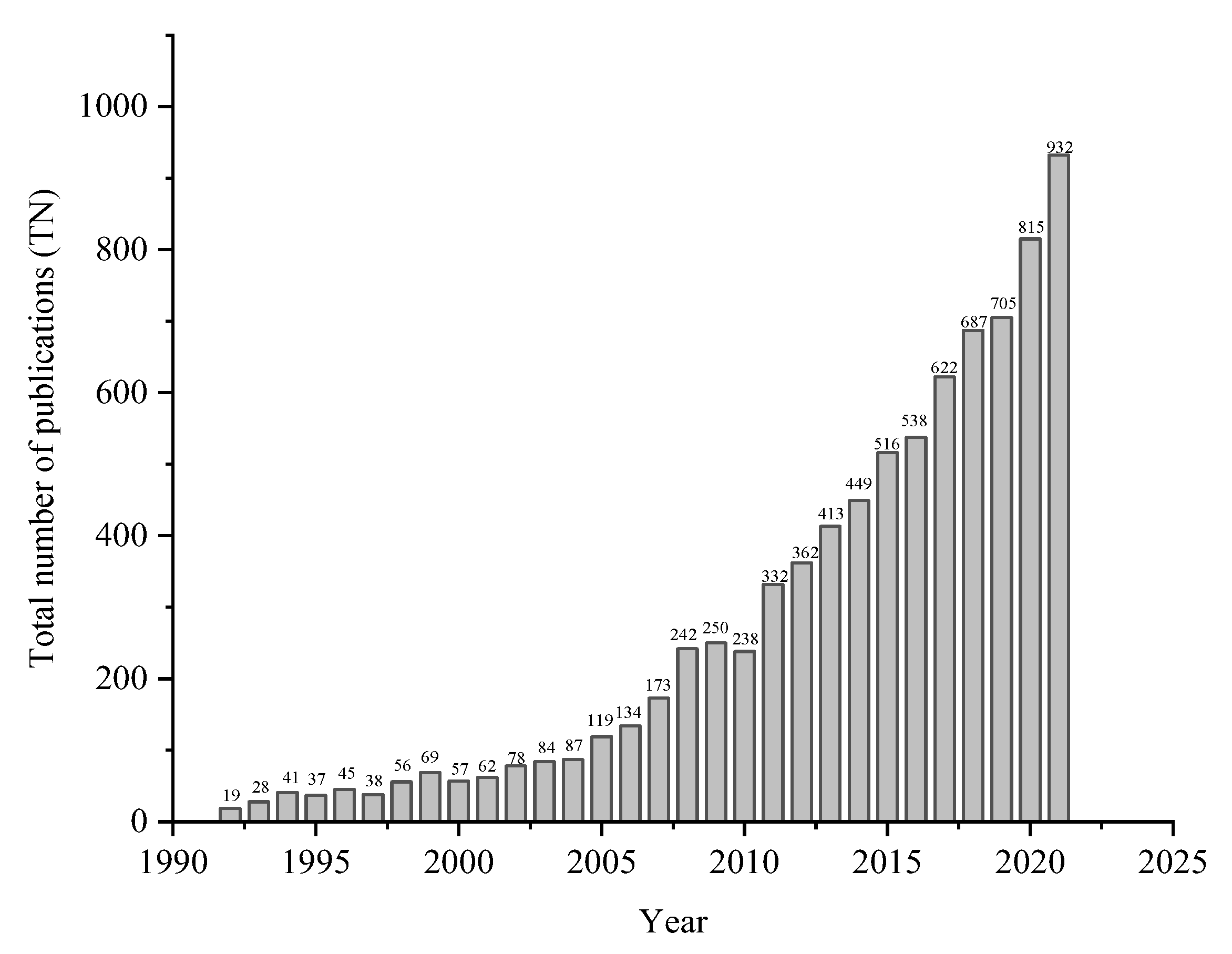
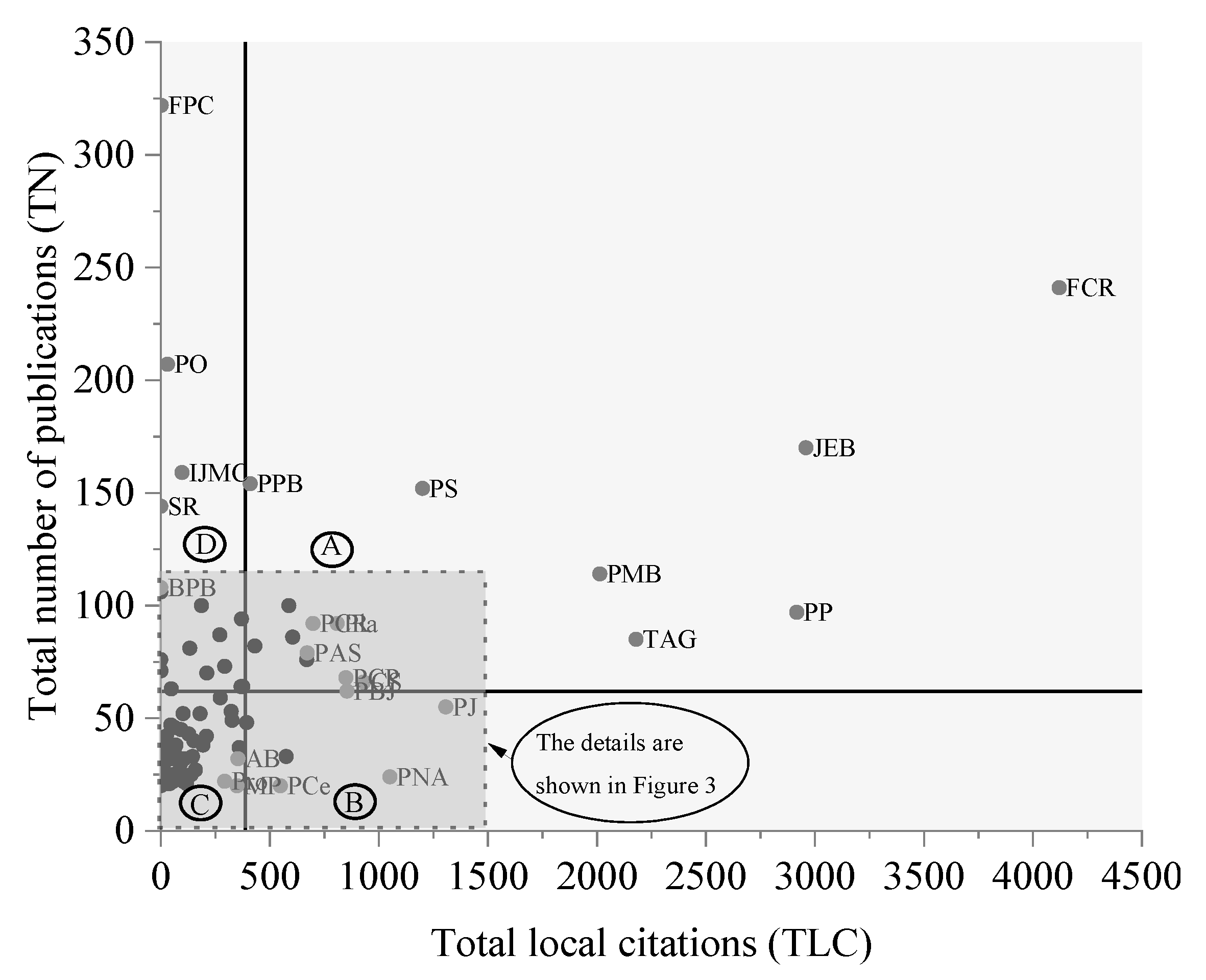
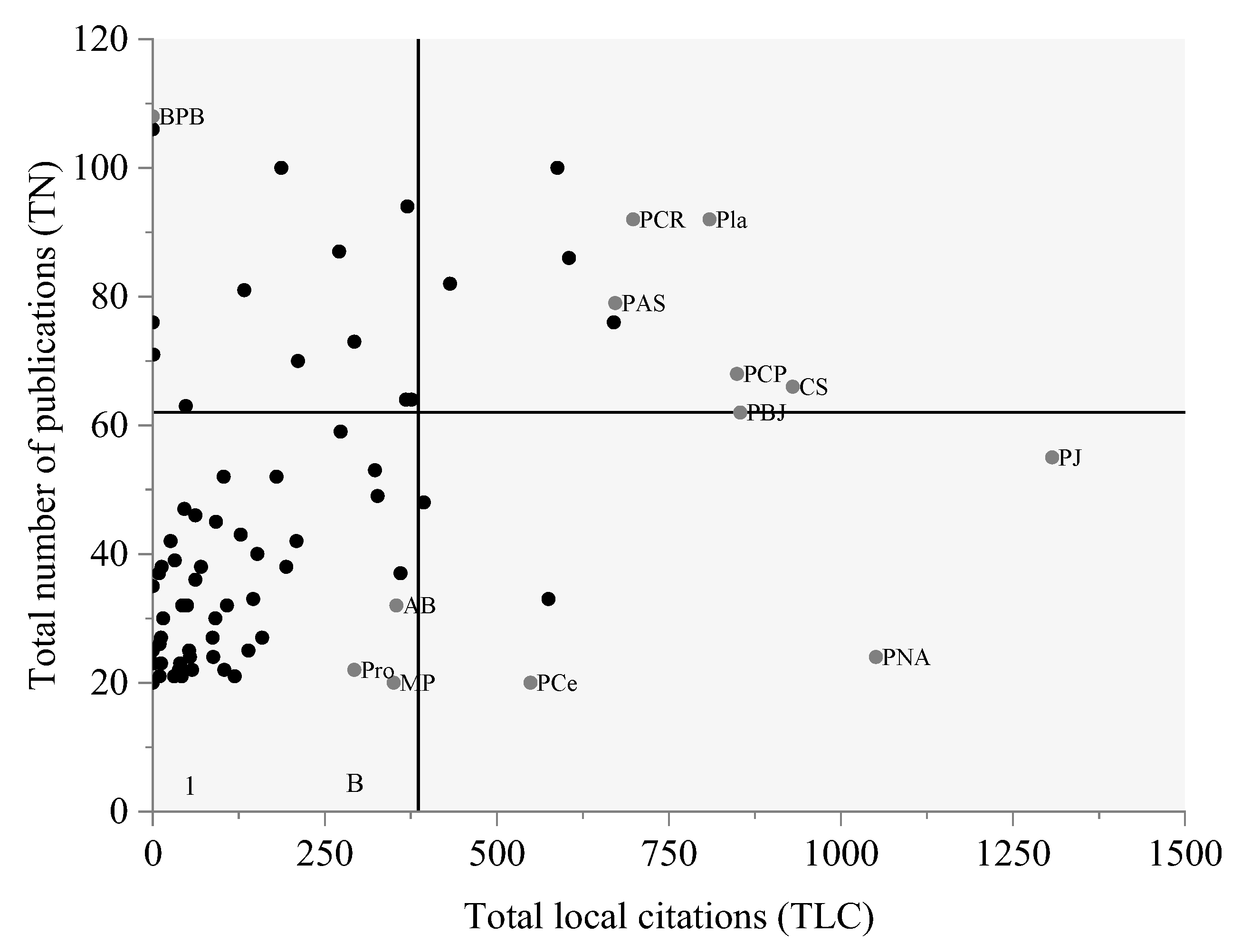
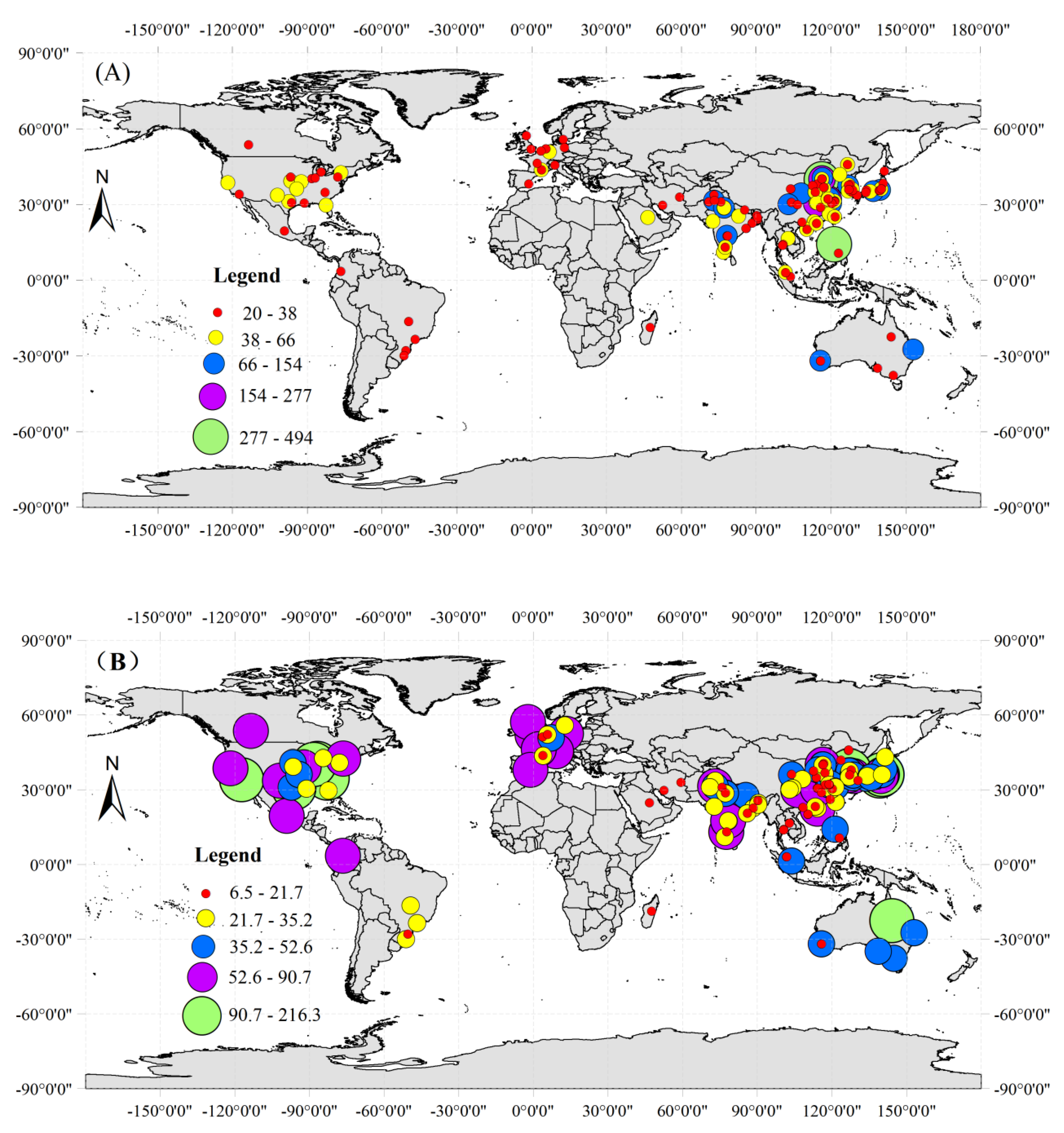
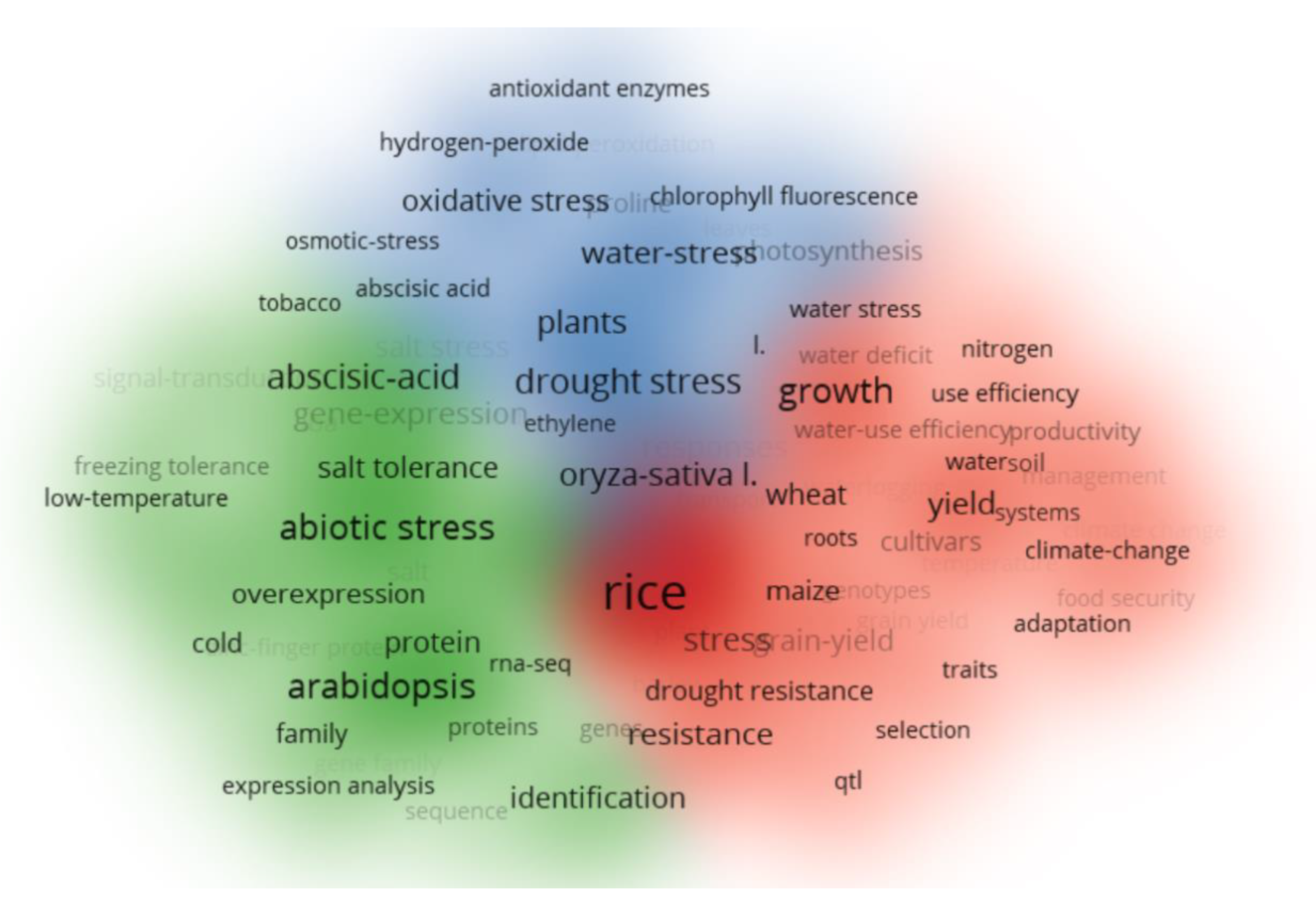
| Rank | Categories | TN | TN(%) |
|---|---|---|---|
| 1 | Plant Sciences | 3859 | 46.6 |
| 2 | Agronomy | 1607 | 19.4 |
| 3 | Biochemistry Molecular Biology | 1005 | 12.1 |
| 4 | Genetics Heredity | 688 | 8.3 |
| 5 | Environmental Sciences | 678 | 8.2 |
| 6 | Biotechnology Applied Microbiology | 546 | 6.6 |
| 7 | Multidisciplinary Sciences | 503 | 6.1 |
| 8 | Agriculture Multidisciplinary | 406 | 4.9 |
| 9 | Soil Science | 311 | 3.8 |
| 10 | Horticulture | 292 | 3.5 |
| Journals | Label | NO. (TN) | NO. (TLC) | TGC | NO. (TGC/TN) |
|---|---|---|---|---|---|
| Frontiers in Plant Science | FPC | 1(322) | /(2) | 10,168 | /(31.6) |
| Field Crops Research | FCR | 2(241) | 1(4121) | 12,438 | /(51.6) |
| PLoS One | PO | 3(207) | /(31) | 7014 | /(33.9) |
| Journal of Experimental Botany | JEB | 4(170) | 2(2959) | 16,697 | 5(98.2) |
| International Journal of Molecular Sciences | IJMC | 5(159) | /(97) | 2515 | /(15.8) |
| Plant Physiology and Biochemistry | PPB | 6(154) | /(410) | 3500 | /(22.7) |
| Plant Science | PS | 7(152) | 7(1201) | 7727 | /(50.8) |
| Scientific Reports | SR | 8(144) | /(0) | 3627 | /(25.2) |
| Plant Molecular Biology | PMB | 9(114) | 5(2014) | 8033 | 10(70.5) |
| BMC Plant Biology | BPB | 10(108) | /(0) | 3432 | /(31.8) |
| Plant Physiology | PP | /(97) | 3(2917) | 11,770 | 3(121.3) |
| Planta | Pla | /(92) | 12(809) | 3968 | /(43.1) |
| Theoretical and Applied Genetics | TAG | /(85) | 4(2180) | 6415 | 9(75.5) |
| Plant and Cell Physiology | PCP | /(68) | 11(849) | 4351 | /(64) |
| Crop Science | CS | /(66) | 9(930) | 2471 | /(37.4) |
| Plant Biotechnology Journal | PBJ | /(62) | 10(854) | 3957 | /(63.8) |
| Plant Journal | PJ | /(55) | 6(1307) | 5841 | 4(106.2) |
| Annals of Botany | AB | /(32) | /(354) | 2853 | 6(89.2) |
| PNASUSA | PNA | /(24) | 8(1051) | 6522 | 1(271.8) |
| Proteomics | Pro | /(22) | /(293) | 1916 | 8(87.1) |
| Plant Cell | PCe | /(20) | /(549) | 3771 | 2(188.6) |
| Molecular Plant | MP | /(20) | /(350) | 1751 | 7(87.6) |
| Rank | Items | TN | TN(%) | TGC | TGC/TN |
|---|---|---|---|---|---|
| Top 10 authors | |||||
| 1 | Kumar, Arvind (National Rice Research Institute, Philippines) | 88 | 1.07 | 3783 | 43.0 |
| 2 | Xiong, Lizhong (Huazhong Agricultural University, China) | 63 | 0.77 | 7782 | 123.5 |
| 3 | Henry, Amelia (National Rice Research Institute, Philippines) | 42 | 0.51 | 1564 | 37.2 |
| 4 | Zhang, Jianhua (Chinese University Hong Kong, China) | 41 | 0.50 | 1680 | 41.0 |
| 5 | Kim, Ju-kon (Seoul National University, South Korea) | 38 | 0.46 | 2591 | 68.2 |
| 6 | Luo, Lijun (Shanghai Agrobiol Gene Center, China) | 37 | 0.45 | 1389 | 37.5 |
| 7 | Dixit, Shalabh (National Rice Research Institutet, Philippines) | 35 | 0.43 | 1617 | 46.2 |
| 7 | Li, Zhikang (Chinese Academy of Agricultural Sciences, China) | 35 | 0.43 | 747 | 21.3 |
| 7 | Yamauchi, Akira 9 (Nagoya University, Japan) | 35 | 0.43 | 1169 | 33.4 |
| 8 | Chen, Liang (Shanghai Agrobiol Gene Centerr, China) | 31 | 0.38 | 627 | 20.2 |
| 9 | Kato, Yoichiro (University Tokyo, Japan) | 29 | 0.35 | 709 | 24.4 |
| 10 | Serraj, Rachid (National Rice Research Institute, Philippines) | 28 | 0.34 | 2044 | 73.0 |
| Top 10 institutions | |||||
| 1 | Chinese Academy of Sciences (China) | 494 | 6.0 | 24,544 | 49.7 |
| 2 | International Rice Research Institute (Philippines) | 405 | 4.9 | 21,142 | 52.2 |
| 3 | Chinese Academy of Agricultural Sciences (China) | 334 | 4.0 | 9304 | 27.9 |
| 4 | Huazhong Agricultural University (China) | 277 | 3.3 | 15,823 | 57.1 |
| 5 | Nanjing Agricultural University (China) | 235 | 2.8 | 6899 | 29.4 |
| 6 | China Agricultural University (China) | 172 | 2.1 | 6996 | 40.7 |
| 7 | Zhejiang University (China) | 154 | 1.9 | 5046 | 32.8 |
| 8 | University Tokyo (Japan) | 140 | 1.7 | 9938 | 71.0 |
| 9 | Northwest Agriculture and Forestry University (China) | 137 | 1.7 | 4196 | 30.6 |
| 10 | University of Western Australia (Australia) | 115 | 1.4 | 5294 | 46.0 |
| Top 10 Countries | |||||
| 1 | China | 3209 | 38.8 | 101,277 | 31.6 |
| 2 | India | 1375 | 16.6 | 39,294 | 28.6 |
| 3 | USA | 1011 | 12.2 | 45,168 | 44.7 |
| 4 | Japan | 700 | 8.5 | 35,550 | 50.8 |
| 5 | Australia | 484 | 5.8 | 20,722 | 42.8 |
| 6 | Philippines | 459 | 5.5 | 20,258 | 44.1 |
| 7 | South Korea | 439 | 5.3 | 14,707 | 33.5 |
| 8 | Pakistan | 307 | 3.7 | 9695 | 31.6 |
| 9 | Germany | 276 | 3.3 | 15,038 | 54.5 |
| 10 | UK | 270 | 3.3 | 15,694 | 58.1 |
| Rank | Authors (year) | TLC | TGC | TLC/t | TGC/t | No. (LCSe) |
|---|---|---|---|---|---|---|
| 1 | Dubouzet, Emilyn G. 2003 [50] | 404 | 1097 | 21.3 | 57.7 | 2(57) |
| 2 | Hu, Honghong. 2006 [58] | 345 | 945 | 21.6 | 59.1 | 3(53) |
| 3 | Shinozaki, Kazuo. 2007 [52] | 235 | 1498 | 15.7 | 99.9 | 9(33) |
| 4 | Jeong, Jin Seo. 2010 [53] | 234 | 461 | 19.5 | 38.4 | 4(50) |
| 5 | Nakashima, Kazuo. 2007 [54] | 231 | 683 | 15.4 | 45.5 | 5(42) |
| 6 | Fukai S. 1995 [58] | 218 | 364 | 8.1 | 13.5 | / |
| 7 | Rabbani, M. Ashiq. 2003 [59] | 213 | 712 | 11.2 | 37.5 | / |
| 8 | Xiang, Yong. 2008 [55] | 210 | 386 | 15.0 | 27.6 | 6(38) |
| 9 | Ito Yusuke. 2006 [60] | 209 | 572 | 13.1 | 35.8 | / |
| 10 | Uga Yusaku. 2013 [56] | 201 | 675 | 22.3 | 75.0 | 1(67) |
Publisher’s Note: MDPI stays neutral with regard to jurisdictional claims in published maps and institutional affiliations. |
© 2022 by the authors. Licensee MDPI, Basel, Switzerland. This article is an open access article distributed under the terms and conditions of the Creative Commons Attribution (CC BY) license (https://creativecommons.org/licenses/by/4.0/).
Share and Cite
Pan, X.; Wang, H.; Ouyang, Z.; Song, Z.; Long, H.; Luo, W. Scientometric Analysis on Rice Research under Drought, Waterlogging or Abrupt Drought-Flood Alternation Stress. Agriculture 2022, 12, 1509. https://doi.org/10.3390/agriculture12091509
Pan X, Wang H, Ouyang Z, Song Z, Long H, Luo W. Scientometric Analysis on Rice Research under Drought, Waterlogging or Abrupt Drought-Flood Alternation Stress. Agriculture. 2022; 12(9):1509. https://doi.org/10.3390/agriculture12091509
Chicago/Turabian StylePan, Xiaoyan, Hui Wang, Zan Ouyang, Zifan Song, Hongjin Long, and Wang Luo. 2022. "Scientometric Analysis on Rice Research under Drought, Waterlogging or Abrupt Drought-Flood Alternation Stress" Agriculture 12, no. 9: 1509. https://doi.org/10.3390/agriculture12091509
APA StylePan, X., Wang, H., Ouyang, Z., Song, Z., Long, H., & Luo, W. (2022). Scientometric Analysis on Rice Research under Drought, Waterlogging or Abrupt Drought-Flood Alternation Stress. Agriculture, 12(9), 1509. https://doi.org/10.3390/agriculture12091509






